BBVA Colombia, a story of 60 years
BBVA Colombia is 60 years old: six decades dedicated to promote economic growth. We review its history from the livestock fairs, the first office and its growth par with the needs of Colombian people, to become a model of innovation in the financial sector.


It all began in the 1950s...
BBVA Colombia was founded in 1956, a difficult decade for a country marked by deep political divisions and violence, but paradoxically considered by analysts to be the decade when the modernization of education, banks and industry began. The bank was established under the name Banco Ganadero Popular, coinciding with Farmers’ Day. The announcement was made at the First Agricultural Fair.
Although today Colombia is the second most biodiverse country in the world with great potential for rural development, nearly the entire country worked in the countryside in the middle of the 20th Century. This is why Banco Ganadero’s main mission was to promote and foment agriculture.
Dedication and leadership
Banco Ganadero showed its dedication and leadership since its doors first opened, growing at the same pace as the country and playing a prominent role in the Colombian economy. Under President Alberto Lleras Camargo, Law 26 was enacted in 1959, which determined that 80% of the bank would be privately owned and 20% would be owned by the government.

Firts office and headquarters of Banco Ganadero in Bogotá.
Following the 1950s – a tumultuous decade for politics – Colombia embarked on a period of institutional stability starting in 1958 with an agreement between the liberal and conservative political rivals. The so-called National Front (Frente Nacional) consisted of alternating presidents from each political party every four years. This period of history concluded in 1974 with the end of conservative Misael Pastrana Borrero’s mandate.
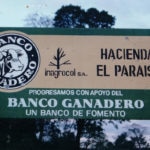
The 60s, huge growth and development
Since the 1960s, the country entered a long period of institution building and constant economic growth. Banco Ganadero also consolidated its position in the market during this period.
Although the bank was established in Bogotá and its headquarters was initially in the capital city, its agricultural focus made it necessary to expand to the different regions of the country. In the 1970s and 1980s, the bank started an administrative and operational decentralization process leading to the establishment of what were referred to as “regional vice-presidencies.”
In 1986, Banco Ganadero was listed on the stock market. In 1990, the government decided to sell part of its shares
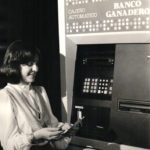
This is how ATMs looked in the 1980s.
The bank’s growth was so dynamic that it became a banking leader at a national level. In the 1980s, the bank decided to expand internationally with the opening of Banco Ganadero Miami in 1982.
In 1986, Banco Ganadero was listed on the stock market. In 1990, the government decided to sell part of its shares, lowering its stake in the bank to 10%.
Banco Ganadero became the first Colombian company to be listed on the New York Stock Exchange

In the early 1990s, Banco Ganadero was the leading institution in the Colombian market. The bank’s future outlook was so great that in 1994 a historic event took place for the economy and Colombian businesses. Banco Ganadero became the first Colombian company to be listed on the New York Stock Exchange.
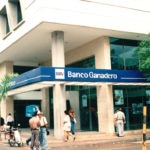
The arrival of BBV
Big Spanish banks looked to Latin American markets when they started to expand internationally in the mid-1990s. Cultural affinity, language and even having the same business opportunities made Latin America the ideal place to expand. Starting in 1995, then BBV (Banco Bilbao Vizcaya) decided to begin its expansion in America by purchasing stakes in leading banks in different countries.
It was this internationalization plan that brought BBV to Colombia in 1996, purchasing 34.7% of Banco Ganadero’s outstanding shares. The COP327 million operation took place on the Bogotá Stock Exchange.
Subsequently, in 1998, through a public exchange offer, BBV agreed to buy a block of shares issued by Banco Ganadero, increasing its stake to 49.14%.

Annual General Meeting in 1998.
As the bank’s largest shareholder gained importance, the decision was made to make major changes for the future of the bank.
In 1998, the bank was renamed BBV Banco Ganadero, and its corporate image completely changed. Its logo used to feature a cow – in reference to livestock - and was green due to its agricultural focus. The new corporate image was predominately blue.
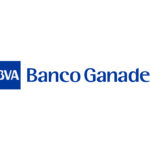
Argentaria arrives
There is no doubt that the business world is quite dynamic and so is the financial world. By the end of the last century, a wave of bank mergers swept across the world, seeking to build bigger and stronger banks, more capable of facing the different domestic and foreign challenges that lied ahead.
The biggest players in the Spanish banking sector announced mergers. In 1999 BBV announced its merger with Argentaria, resulting in what today we know as BBVA (Banco Bilbao Vizcaya Argentaria).
In line with the events that took place in the parent company, Colombia adopted the new international denomination, and the bank was renamed BBVA Banco Ganadero.
Following the pace of the economy
By the end of the 1990s, Colombia faced a delicate economic crisis, triggered mainly by the main financial institutions as a result of the collapse UPAC-based mortgage lending system. Over 20 institutions supervised by the Banking Superintendence were intervened to prevent a higher impact on the economy as a whole, which still was strongly affected in 1999 with a 5% GDP.
Precisely, in order to lay a sound and solid basis for the future development of the bank, in year 2000, BBVA invested COP570 billion in the expansion of BBVA Banco Ganadero’s capital, as a result of which it increased its stake in the bank to 88.67%.
In April 2001, through a takeover bid launched simultaneously in the US and Colombia stock exchanges, BBVA managed to increase its stake in the share capital of BBVA Banco Ganadero to 94.16%.
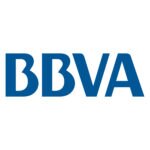
2004, brand change
In April 2004, BBVA Banco Ganadero adopted integrally the name of its holding company and was renamed Banco Bilbao Vizcaya Argentaria Colombia S.A. (BBVA Colombia). This step bore witness to both Grupo BBVA’s strong commitment to the development of its businesses in Colombia and its confidence in the Colombian economy.
In May 2006, the two institutions merged under the brand BBVA Colombia

Purchase of Granahorrar
After the crisis of the 1990s, the 21st century arrived with years of strong economic expansion, and BBVA remained firm in its commitment to accompany the country’s development.
This is why, in order to continue growing and strengthening its operation in the country, BBVA decided to participate in the state-controlled bank privatization processes. In October 31st, 2005, BBVA Colombia won a public auction that allowed it to take control over Banco Granahorrar, in an operation that closed at COP970 billion.
In May 2006, the two institutions merged under the brand BBVA Colombia, in a movement that gave rise to the country’s largest mortgage lending institution, with nearly 800 ATMs and 359 branches.
Progress continues
The years following BBVA’s Granahorrar takeover were marked by the solid performance of the Colombian economy, the development of business underpinned by the great growth potential of the Colombian economy, which helped the country start playing a more prominent role in international markets, becoming a key destination for foreign investments.
Over the last 10 years, Colombia has become one of the most appealing countries for large international capitals, a fact that has been reflected both in the valuation of its assets, and, of course, in the country’s GDP growth rates.
In 2007, BBVA ratified its commitment to the country by pledging to devote 1% of the bank's yearly earnings to corporate social responsibility actions. This public commitment is rooted on the bank’s firm conviction of contributing not only to the development of business, but to the country’s development, by providing support to projects with high social impact projects.
BBVA became the first bank in the country to implement corporate social responsibility policies

Plan Becas BBVA is one of the corporate social responsibility projects of BBVA Colombia.
Thus, BBVA became the first bank in the country to implement corporate social responsibility policies in accordance with international standards and a future vision, implementing sustainable development practices in all its actions.
In 2013, BBVA Colombia, firmly determined to continue consolidating its franchise in the country, decided to roll out an ambitious expansion plan that envisaged opening 100 new branches and deploying 500 new ATMs, hiring 2,000 new employees for the organization, with investments in excess of $400 million.
By the end of 2015, BBVA Colombia successfully concluded its expansion plan, with a total of 412 branches, more than 1,200 ATMs and over 5,500 employees, plus significant growth in its P&L account, with net earnings of COP603 billion.
As regards corporate responsibility, BBVA concluded year 2015 with investments of over COP6 billion pesos, which benefitted over 130,000 people with limited resources.

BBVA's headquarters in Bogotá.
In recent years, BBVA Colombia has made big investments in innovation and technology in order to lead the market under the new business environment.
The digital revolution has already had a major impact on the market and will clearly change the way business is conducted in the future. BBVA understands these challenges and has been working to be a leader in the new environment.
Today, BBVA Colombia is a young, 60 year old bank with a bright future ahead.